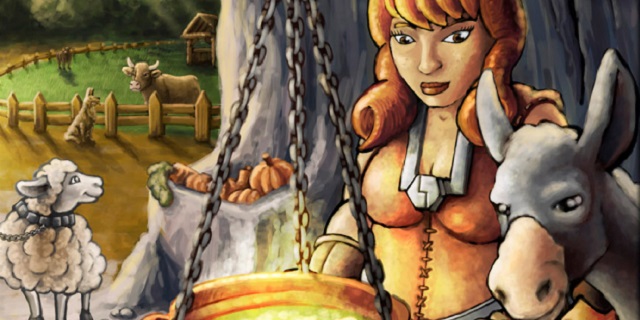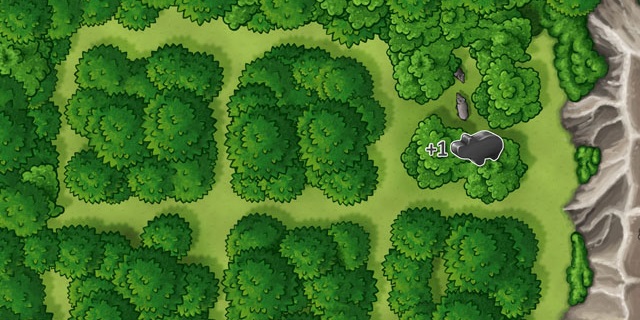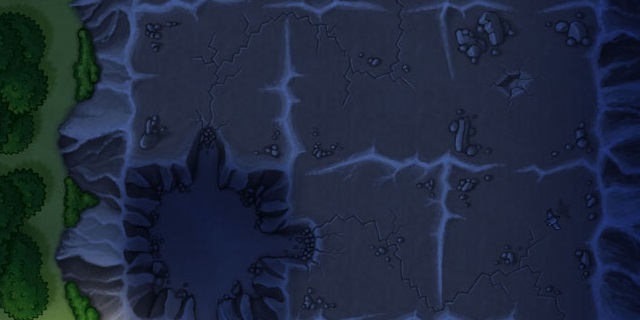
Seven years ago, Uwe Rosenberg’s Agricola took the modern board gaming world by storm, winning award after award and entrenching itself firmly atop the BoardGameGeek.com ratings, where it still resides comfortably as the third highest-rated game of all time. Its not flawless by any means, and many gamers opt to not even use the best — and to be fair, most complicated — aspect of the game: the occupation and minor improvement cards. The “family game” version sacrifices variability for simplicity, but loses little to none of the worker-placement struggle to avoid starvation as you develop your own farm. Now Rosenberg has revisited many of his Agricola mechanics for a sequel of sorts in Caverna: The Cave Farmers, which eliminates the cards altogether to provide one unified experience.
Taking the place of the various decks of cards are an assortment of room tiles that function similarly to either Agricola’s room extensions or the major improvement cards that are always available in that game. These tiles are always the same each game, but with the exception of the basic Dwelling tile each room is unique so it’s first-come, first-served. What you won’t need to worry about, however, is being unable to convert your animals to food if you wish to do so. In Agricola you needed specific improvements to do this, but in Caverna each player has that ability inherently, making being unable to feed your family a much less likely proposition.

Without as much risk of being penalized for having too many workers, Caverna balances that by having workers be much less valuable at the end of the game (one point vs. Agricola‘s three) as well as by making feeding more frequent and less predictable. Harvesting and feeding still happens after certain rounds, but one round forces you to feed one food per worker without the benefit of a harvest and the later rounds of the game might have a full harvest, no harvest, a minor feeding, or a half-harvest in which you must choose to either skip collecting grain/vegetables or breeding your animals before a full feeding. The number of each event is always the same, but like the actions available each round the actual order in which they will occur is somewhat variable.
That said, Caverna is still a worker-placement game and it is still in your best interest to increase your stock of workers as soon as possible. Caverna‘s actions are more substantial than its predecessor’s, however, so you might not need as many to accomplish your goals. Instead of simply gaining one type of resource with a single action, most spaces offer multiples types or come with an additional benefit like clearing spaces on your board for future development. Speaking of resources, Caverna still features wood and stone, but has traded in reed for ore (because dwarfs) and added rare rubies that can be traded for almost anything at any time or kept for additional points at the end of the game.

On the subject of points, the scoring system has been significantly revamped. Players are now only penalized for uncleared spaces on their farm/cave boards and for lacking at least one representative of each of the four animal types, with mule joining the familiar sheep, boar, and cow; dogs are also a new option, and can even take care of un-penned sheep, but are not penalized. More importantly, there is no upper limit to scoring for any category. If you have a giant herd of cows, for example, you will score for each one of them instead of having everything over a given cap being essentially wasted. This increased flexibility allows players to pursue their own strategies without being forced into a more well-rounded game plan.
Also offering additional options is the new expedition mechanic. Once you have turned ore into weapons via a blacksmithing action, your armed dwarfs can take actions to go exploring. The stronger the worker, the more choices you have for which rewards they bring home. Workers get stronger after each expedition, and the strongest are capable of some amazingly valuable actions if you build them up enough. This power comes at a price, however, as you must place your workers in increasing order from weakest to strongest. By the time you get you place your strongest workers, the best expedition actions might all be gone. You may spend a ruby to break that rule for your current turn, but then you aren’t using that ruby for any one of its other valuable effects.
All of these choices might seem overwhelming, although Agricola veterans will feel right at home and adapt immediately. I haven’t yet had the opportunity to see how a completely new player will react to Caverna‘s dizzying array of options. It might very well be too much for them, but Caverna still seems more newbie-friendly than Agricola due to how much more useful each action is and the lack of diversity-related scoring penalties. Also worth mentioning is the fact that Caverna‘s rule book is much friendlier than Agricola‘s, which is somewhat infamous for mostly being an intimidating wall of text.

Which is not to say that Caverna can’t be intimidating in its own way. With so much wood, plastic, and cardboard packed into it, the deceptively small box weighs a ton and carries a price tag to match at $80. Although when you consider that Agricola retailed for $70 that isn’t too terrible. Caverna actually feels like much more of a bargain on a pound-for-pound basis, if you want to look at it that way.
Like Agricola, Caverna also supports solo play with a modified set of rules. As many as seven players can play Caverna at once, although be aware that the estimated playing time is half an hour per player and there might be unacceptable amount of down time between turns when playing with six or seven. This of course does not include the set-up and tear-down times, which will vary depending on the organizational skills of those involved but are not insignificant even at the best times.
For all of Caverna‘s improvements over Agricola, Agricola remains the “better” game just for the variety and deeper strategy offered by its modular decks of cards. It is entirely possible to pursue the same strategy in Caverna every time if you were so inclined, which will get old fast if you let it. But for most general purposes and audiences, Caverna will shine where Agricola falters. If you enjoy Agricola‘s “family game” then upgrading to Caverna would be a sound investment, especially if you don’t already own Argicola yourself. For those of us who do already own Agricola the upgrade might be harder to justify, although a game of this quality can be hard to ignore for long.



















